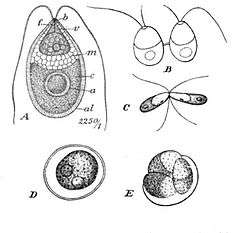Dunaliella
| Dunaliella | |
|---|---|
 | |
| Dunaliella salina Teodor. A: Vegetative cell, B: Zoospores in cell division, C: Mating gametes, D: Ripe zygospore, E: Zygospore germination | |
 | |
| Scientific classification | |
| Domain: | Eukaryota |
| Kingdom: | Viridiplantae |
| Phylum: | Chlorophyta |
| Class: | Chlorophyceae |
| Order: | Chlamydomonadales |
| Family: | Dunaliellaceae |
| Genus: | Dunaliella |
| Species | |
| |
Dunaliella is a genus of the algae family Dunaliellaceae.[1] Dunaliella sp. are motile, unicellular, rod to ovoid shaped (9−11 µm) green algae (Chlorophyceae), which are common in marine waters. The organisms are relatively simple to cultivate and do not clump or form chains.
Species
The best-known species is the extremely salt tolerant Dunaliella salina Teodor. A new species of Dunaliella was discovered in the Atacama Desert in 2010. It is believed that the algae is sustained by the condensation of water vapor on hanging spider-webs.[2]
Dunaliella tertiolecta is a marine green flagellate with a cell size of 10−12 µm.[3] This strain is reported to have oil yield of about 37% (organic basis). D. tertiolecta is a fast-growing strain and that means it has a high CO2 sequestration rate as well.[4][5]
See also
References
- ↑ See the NCBI webpage on Dunaliella. Data extracted from the "NCBI taxonomy resources". National Center for Biotechnology Information. Retrieved 2007-03-19.
- ↑ "Extreme Microbe Drinks Dew on Spiderwebs to Live". September 22, 2010.
- ↑ http://www.tasmaniatogether.tas.gov.au/schools/tasmania_together_youth_challenge/youthChallenge/Y9-10/Storm_Holwill_Just_a_drop_in_the_ocean.pdf Archived February 19, 2009, at the Wayback Machine.
- ↑ http://www.algaefuels.org/algae_FAQ.htm Archived October 22, 2008, at the Wayback Machine.
- ↑ Regional Forum on Bioenergy Sector Development: Challenges, Opportunities, and Way Forward
Further reading
- Nozaki H, Onishi K, Morita E (2002). "Differences in pyrenoid morphology are correlated with differences in the rbcL genes of members of the Chloromonas lineage (Volvocales, Chlorophyceae)". J Mol Evol. 55 (4): 414–430. doi:10.1007/s00239-002-2338-9. PMID 12355262.
External links
Scientific references
- PubMed references for Dunaliella
- PubMed Central references for Dunaliella
- Google Scholar references for Dunaliella
Scientific databases
Dunaliella tertiolecta
- Dunaliella tertiolecta, cell at 400x in the Dunaliella Culture Collection at Brooklyn College.
- Specification.
- Photosynthetic function in D. tertiolecta (chlorophyta), during a nitrogen starvation and recovery cycle.
- Ultrastructure of Dunaliella tertiolecta Cells Grown under Low and High CO2 Concentrations.
- In vitro inhibition of the replication of haemorrhagic septicaemia virus (VHSV) and African swine fever virus (ASFV) by extracts from marine microalgae Dunaliella tertiolecta].
- NCBI taxonomy page for Dunaliella
- Search Tree of Life taxonomy pages for Dunaliella
- Search Species2000 page for Dunaliella